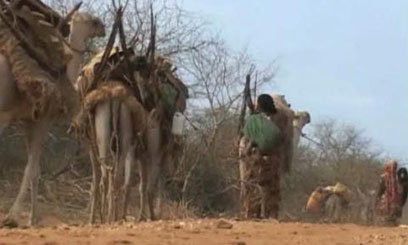MOYALE, Kenya, Aug 3 – Drought and famine are causing widespread hardship across the Horn of Africa, resulting in high death rates, malnutrition, disease, loss of cattle, and other calamities.
But several communities in northern Kenya, backed by aid groups, have managed to reduce the impacts of the drought through forward-looking policies such as livestock de-stocking, essential nutritional programs, and resource sharing.
The worst drought and famine to ravage the Horn of Africa in decades is having devastating results. For pastoralist communities, the death of cattle due to lack of pasture and water is the end of families’ incomes. Those cattle remaining are malnourished and sickly, in danger of dying at any moment.
Residents of the village of Funan-Qumbi in northern Kenya are not waiting for their cattle to die.
The animals are being slaughtered and their meat distributed to the area’s most vulnerable families through a European Commission-funded program that buys their cattle at higher-than-market prices.
Twenty of Abdub Guyo’s 30 animals died because of the drought. Today he has sold two goats.
“I thought it was wiser and better to sell my goats rather than lose them to the drought,” Guyo said.
Benoit Collin, the European Commission’s Disaster Risk Reduction coordinator, says the program gives the villagers a good price for their livestock.
“Then they have some earnings, and they have been able to use these earnings for water trucking, for buying food for the family, etc,” Collin said.
This is one of many initiatives that local communities, through donor support, are taking in advance to reduce the impact of drought and famine.
At the Kinisa Dispensary two hours away, malnutrition rates among children are lower than the average in other famine areas.
Head nurse Adan Sake says his clinic started following a 12-point intervention when early warning signs became apparent. “We usually de-worm children after every three months. We provide Vitamin A supplementation. We also give zinc tablets for diarrheal cases. We also promote exclusive breastfeeding to mothers. We encourage supplementation of micro-nutrients. We provide hygiene services. These are part of the interventions that is containing the situation,” Sake said.
Since the beginning of the year, health officials have also held mass screenings of village children, to look for and treat signs of malnutrition.
In northern Kenya, communities are sometimes at war with one another over resources or other issues.
Doatu Elea, an elder in Funan-Qumbi, is chairman of the village’s Disaster Risk Reduction Committee.
With donor support, he says, his Borana community held negotiations with the Gabra community, and agreed to share pasture, water, and other resources to reduce the impacts of drought.
“Everyone was so tired of war – the effect is just disasters. Although we fight, we have a lot in common with this community – there are intermarriages, we are in marginalized areas, we have the same religion,” Elea said.
Communities in dry areas have many ways of coping with drought. Neighbours share resources, pastoralists move their animals up to hundreds of kilometres away looking for pasture, and food is rationed in emergency situations.
Saphia Abdi, a program officer for the aid group “Cordaid,” says most communities have what she calls “traditional early warning systems” where they know in advance when there is going to be a drought. She says they can tell by examining the contents of animal intestines, and gazing at the stars.
“They can also look at general animal behaviour. So, if the animal moves, or faces one side, or when they make certain noises, they know it is going to be bad drought,” Abdi said.
Abdi says the most successful programs are those in which communities get donor support to fund their own ways of coping with drought, as in the case of Funan-Qumbi and Kinisa.
“So you can see organizations like Concern with their health outreach program, you can see Cordaid and SIFA coming in with de-stocking where they benefit from the meat, you can see the tanks here so they get access to water. So being prepared in terms of even having that plan is a plus for the community here,” Abdi said.
This report was filed by Cathy Majtenyi










































